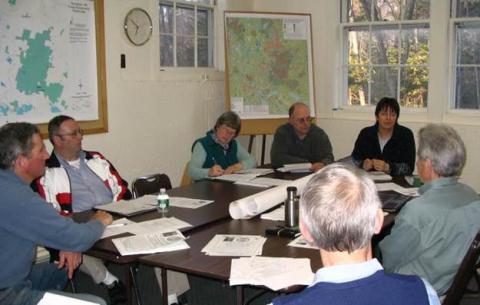
Addressing the natural resources needs of your community will take good leadership and support. Follow the steps below to organize your project.
- This could be a subcommittee of the conservation commission or another town board. A NRI that relies primarily on volunteers will be accomplished most effectively by pooling a variety of talent into a well-organized work group.
- Invite representatives from local boards, community groups (e.g. historic society, agricultural commission, etc) and interested area residents to be part of a smaller work group of 4-6 people to work on the NRI project. Identify people in town who have professional natural resources backgrounds and are willing to assist.
- Select a project leader/coordinator or co-leaders.
- Determine the technical capacity of the group and identify what assistance you might need.
- Review community needs and identify short- and long-term goals. Goals can be specific (e.g. wetland evaluation, water resources assessment) or broad (conservation planning, updating the master plan, updating regulations, public education etc.).
- Identify specific natural resources priorities in town, such as water resources, wildlife habitat, farmlands or scenic views.
- Determine the need of your community to establish a detailed or basic natural resources inventory.
- Are natural resources goals identified in the master plan? How can the NRI address some of the recommendations?
- What do you hope to accomplish with your NRI? How will it be used?
The study area for a community level natural resources inventory could be a town, a watershed or a region.
- Municipal Boundary: Recognizing that natural resources cross municipal boundaries, it is important to include a portion of the area that extends beyond the municipal boundary on the NRI maps.
- Local Watersheds: Since issues like water quality, water quantity and source water protection also extend beyond political boundaries, watersheds provide logical units to study and manage natural resources.
- Regional Studies: Some regional conservation initiatives have inventoried resources based on a region or watershed that encompasses multiple communities, e.g. Quabbin To Cardigan, Lakes Region Conservation Plan, Land Conservation Plan for New Hampshire's Coastal Watersheds, and the Merrimack River Watershed Conservation Plan, to name a few.
- Collect and review existing natural resources documents/studies for your study area, e.g., a previous NRI, natural resources maps, Natural Resources chapter of the master plan, other relevant documents held by other municipal boards, and studies done by your regional planning commission, private consultants and other groups. This will help avoid duplication and can provide a head start on your NRI.
- Review any previous conservation priorities you may have.
- Develop a draft NRI outline to address project goals. Refer to the Sample NRI Outline or existing community NRI examples under "Natural Resources Inventories" section to get ideas about structuring your NRI.
- See NRI Components for a list of suggested inventory items, maps and recommended data sources.
- Encourage local boards and commissions to endorse the NRI outline.
- Develop a project timeline, identify tasks and assign responsibilities.
- The cost of a NRI depends on the goals and scope of the project and what resources the community has either in-house (e.g. municipal staff who can produce GIS maps) or via skilled volunteers. Decide if the NRI will be done by a group of volunteers, or if you plan to hire a consultant
- Investigate the costs of producing maps from a GIS provider (including large scale poster-size maps) - see Preparing your own NRI maps for more information.
- Factor in other costs, such as hiring a consultant, using student interns, etc., and develop a budget.
- Identify potential funding sources, such as the town's conservation fund, other municipal funds, private grants, etc.).